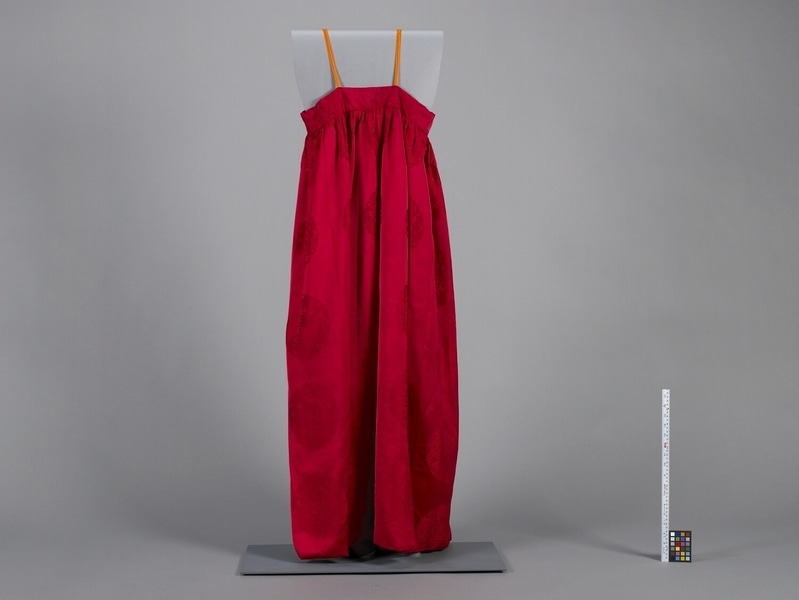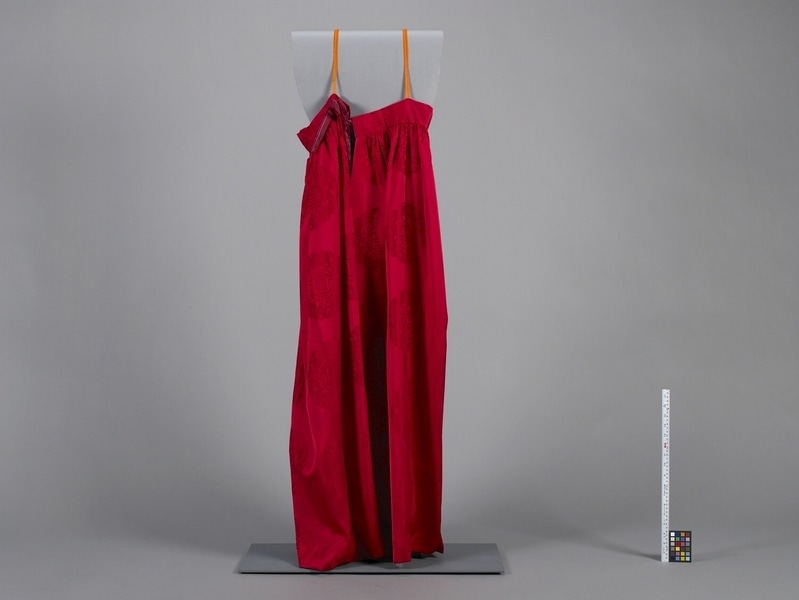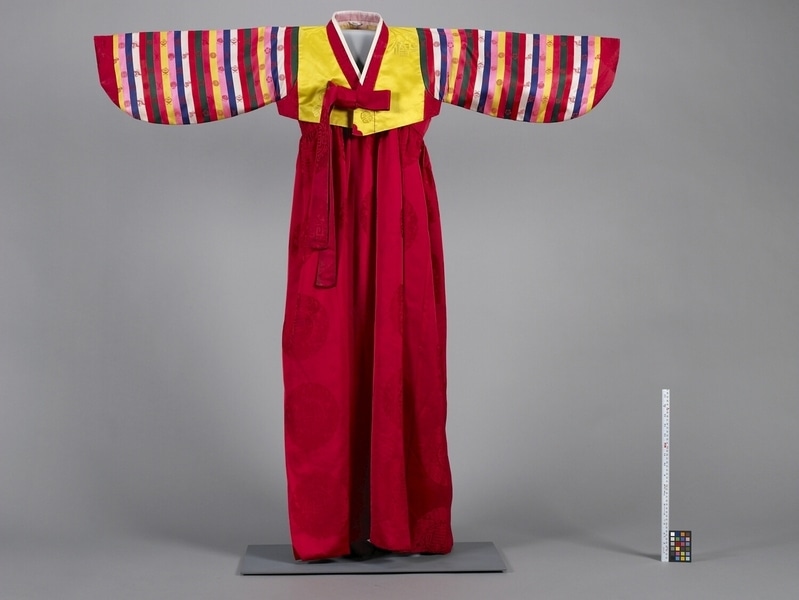Skirt Item Number: 391/1 b from the MOA: University of British Columbia



Description
Red skirt. The skirt is made of three panels of shiny red damask woven with roundels enclosing a bat motif and stylized character. The skirt is open at the back and lined with red nylon mesh. The panels are pleated and inserted into a band of red shiny fabric with a floral pattern and lined with white nylon mesh. The pleats carry through to the edge of the band on the right side, but not the left. The upper edge of the band is straight with two shoulder straps of orange nylon fabric. At both ends of the band are narrow ties of dark red nylon fabric, roughly machine stitched with white thread.
History Of Use
The straps attached to the skirt band, which often was scalloped with the straps attached to the points of the scallops, were innovations introduced after the opening of Korea to the outside world in the late 19th century, replacing the simple waistband with long ties of the traditional “Chi-ma”. The new style was considered to be more modest, as it covered the breasts, and more comfortable. . Such “Chi-ma”, made of synthetic fabrics and worn with jackets “Jo-go-ri” with rainbow “saek-dong” sleeves, were worn by girls and women on festivals and other special occasions. A girl might wear such clothing on her first birthday. By this time the rainbow “saek-dong” sleeves were made of fabric woven in stripes, rather than being pieced as they had been previously. The Korean textile industry had developed to the point that it could produce such fabrics by this time. The relatively small pleats and interfacing produced the voluminous silhouette popular at that time. The skirt band was made of fabric of the same colour because it could be seen under the short jacket “Jo-go-ri”. In the Chosun Dynasty, a white skirt band and ties were considered to be beautiful, but this was no longer the case. By the late 1960s, Korean people generally wore simple clothing so that they could work more efficiently. During the 18 years that Park, Chong-hee was president, the transformation of South Korea from an agricultural country to an industrial one was accomplished, and people were urged to work hard. In compensation, people wore elaborate clothing on special occasions. Those sets with yellow “Jo-go-ri” and red skirts “Chi-ma” were worn by brides. More often than not, a bride spent one or two months after her marriage with her husband’s parents. Every day she was expected to bow to them while wearing her bridal clothing, which she also wore while working in their home. Guests came to see her dressed in her wedding clothes, as her mother-in-law showed her off to them Clothing of this kind was made in markets, and the relatively rough finishing, with the outer fabric folded under to hide the cheaper lining, is typical of that work.
Specific Techniques
The skirt is sewn with machine stitching.
Iconographic Meaning
Bats are symbols of good fortune.
Item History
- Made in Korea before 1977
- Owned by Sang-Hoon Park before June 17, 1977
- Received from Sang-Hoon Park (Donor) on June 17, 1977
What
- Name
- Skirt
- Identification Number
- 391/1 b
- Type of Item
- skirt
- Material
- rayon fibre ?, nylon fibre, cotton fibre and dye
- Manufacturing Technique
- spun, dyed, woven, cut and sewn
- Overall
- height 116.0 cm, width 48.0 cm
Who
- Culture
- Korean
- Previous Owner
- Sang-Hoon Park
- Received from
- Sang-Hoon Park (Donor)
Where
- Holding Institution
- MOA: University of British Columbia
- Made in
- Korea
When
- Creation Date
- before 1977
- Ownership Date
- before June 17, 1977
- Acquisition Date
- on June 17, 1977
Other
- Item Classes
- textiles
- Condition
- good
- Accession Number
- 0391/0001 b